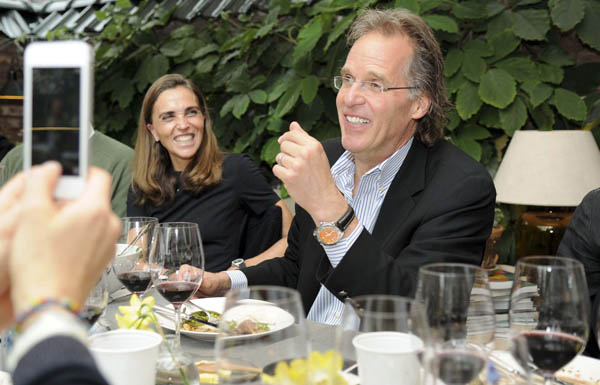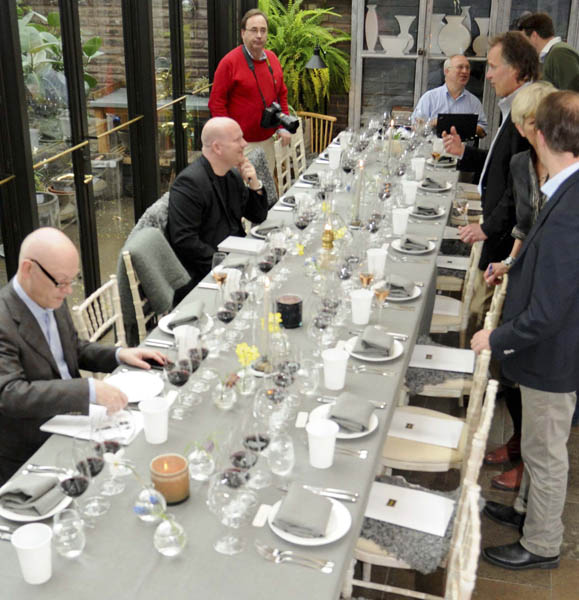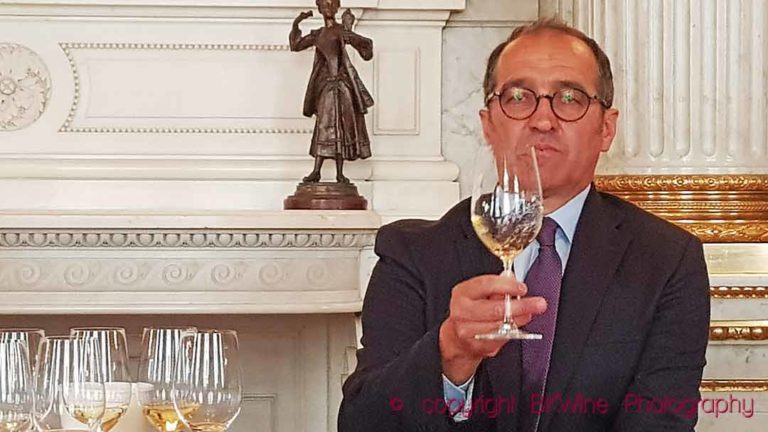Being Relentless – Shafer Vineyards’ Doug Shafer Shares his Views on Wine, Sideways, Hydrogen Sulphide, and How to Steal 300 Gallons of Excellent Cab to Make a Port
#5 of 5. John Shafer started Shafer Vineyards in 1974. In 1984 he was joined by his son Doug Shafer, who now runs the winery. BKWine’s Ulf Bengtsson met Doug Shafer over a wine tasting and lunch. In this fifth and last of five articles Doug talks about the difficulties of quitting, on how to make Californian port from stolen grapes, and of course of terroir. And that Oregon is like France.
This is the fifth of four in a series of articles on Shafer Vineyards. Read them all!:
- Shafer Vineyards (1/5): Becoming a winemaker, and Chardonnay 2012
- Shafer Vineyards (2/5): A catastrophic vintage and the mysterious Stags Leap, and 2011 One Point Five
- Shafer Vineyards (3/5): The quest for perfection and a talented winemaker
- Shafer Vineyards (4/5): Opening 9000 cases of merlot and cabernet
- Shafer Vineyards (5/5): Californian port, stolen grapes and terroir (this article)
Trying to quit
No thoughts on quitting? Leaving the wine business? I ask Dough Shafer.
“I tried to quit, seriously. I tried to resign twice. One time for sure. Once when the 1984 chardonnays got the same scores as the 1985 chardonnays… 68 points! Think about that. I didn’t know they gave scores that low! Anyway, I walked into my dad’s office, after the second 68:
‘I’m done’
‘What do you mean?’
I said, ‘Phhh, two 68s! I’m screwing up the family business. My brothers gonna beat me up, can’t have that. I’m out. I’ve blown it’.
He goes, ‘What did you do wrong?’
‘Heck, I picked them too soon, I had way too much acid, I pumped too much, I shouldn’t… I overfiltered it…’
He goes, ‘Well, don’t make the same mistake twice’.”

How about making pinots?
“Hmm… pinots… I drink pinots. I drink a lot of pinots! Tough wine to make. And for a while I was thinking about it. But then one guy in a restaurant held up a bottle of Shafer merlot and said, ‘See this bottle? Think about this label with pinot noir on it. Make sense?’ They said, ‘Naaaa!’ No sense at all! I don’t want fifteen different flavours of wine. You know, I missed the pinot trail. Too many guys making great pinot out there. No I focus on merlot and cab. I’d love to though. Maybe on the side. In my garage. I don’t want to do 200 cases of something and someone writes it up and no one can get it.”
From making wine in the cellar to making wine in the vineyard
About a year ago I attended a tasting with Gunter Künstler, winemaker in the Rheingau. He said that “I’m not there. I feel, as a winemaker, my job is not to press my style of winemaking into wines. My job is to convert nature into a glass. Without any force, it should be expressed, each soil individually. This is my goal.”
This has also been expressed in Doug Shafer’s book that the movement is towards making wine in the vineyard rather than in the cellar. I asked Doug about this, and he said:
“Around 1990 we began focusing more on vineyard care and on how efforts in the vineyards could directly improve wine quality. The goal is to achieve as much uniform ripeness as possible. All areas of vineyard care are important in these efforts: pruning, frost protection, irrigation, de-leafing, suckering, fruit thinning, etc. Uniform ripeness leads to uniform (and high quality) wines.”
Maybe moving to Oregon?
And on the question of moving to Oregon, one of the most interesting places right now from a winemaking perspective, Doug cannot but exclaim, with a big smile, “Hey, that’s like making wine in France, why would I do that?”
“Took me a lot of beer to understand terroir”
At last, we arrive at the ever eluding concept of terroir. What is terroir, and how is it expressed in a wine? Doug notes that he used to go to Switzerland and hook up with other winemakers, drinking beer. He had many nocturnal and beer-filled discussions with Frederick Brunier of Vieux Télégraphe, about terroir. Frederick finally unveiled it: the concept of terroir is not everywhere, only in certain places. Doug explains this to us: “There’s no terroir in my merlot. But there’s terroir in our Hillside Select. Took me a lot of beers to understand that!”
A sweet wine?
After the main course we are served the dessert. A lovely rhubarb dish. It fits very nicely with the oncoming spring. I cannot but ask, “How about a sweet wine?” Doug replies that in fact, he does make a sweet wine, although it is not included in the tasting.

“I do make a sweet wine. A ‘port’. Ah, that’s another story! Back in 1986 I said, ‘Hey, let’s do some fun this year! Let’s make some port! We’ll make some port and we won’t tell dad.’ So we took some grapes from a vineyard which is called Sunspot, which is the building block of Hillside select. Port’s really easy to make. Boom, you’re done.”
“I walked into his office and said
‘Dad, I want you to try something’.
‘Young port. What’s that?’
‘Dad, we’re making port!’
He goes: ‘Really? What grapes did you use?’
‘Sunspot!’ Which is right outside his window. The vineyards he planted.
He looked at me and said: ‘You took 300 gallons (1100 litres) of my cabernet and you did this to it?’
Ouch! My next thought was, ‘He’s gonna yell!’”
But he did not yell. Instead, he asked Doug for production notes, marketing plan, how it will fit in the line, etc. In other words, the polite version of “right back at ya!” Doug had to go back to his co-conspirer Elias and hand over the bad news: “We’re in trouble. Hide the port!”
The port was hidden and it was not mentioned for four years. Then it needed to be bottled. Doug had to go back to his dad and give him the bad news a second time, that the once stolen cab now had to be bottled. He just said, “Just bottle it and get rid of it. No label, no cap. Just cork. Give it away.” So after bottling, there were a lot of “Merry Christmas, have some port! To the plumber, Merry Christmas, have some port! Mailman, Merry Christmas, have some port!”
But somehow it got itself into a restaurant, and Doug was asked how much there was. “I tell the story, it picks up speed, and people start writing letters to my dad, ‘Dear Mr. Shafer…’ But still no, no. Then we’re sitting at dinner one night, in 1991, with the brother-in-law who is a winemaker. We’re drinking some of this port after dinner. And Joe goes to my dad, ‘Hey, this is pretty good!’ And dad goes ‘You think so?’ ’Yes, you could sell this 90 bucks!’ Next day dad goes, ‘Label the port!’“
I ask Doug if the grapes used for the port still come from the Sunspot vineyard, expecting a “no.” But yes, they still do! Shafer port, or Firebreak as it is called, is still made from the best grapes. Or as Doug puts it, “always great fruit year in and year out!”
Many, many thanks to Doug Shafer for sharing the story of Shafer Vineyards and for letting us taste the wines.
This is the fifth of four in a series of articles on Shafer Vineyards. Read them all!:
- Shafer Vineyards (1/5): Becoming a winemaker, and Chardonnay 2012
- Shafer Vineyards (2/5): A catastrophic vintage and the mysterious Stags Leap, and 2011 One Point Five
- Shafer Vineyards (3/5): The quest for perfection and a talented winemaker
- Shafer Vineyards (4/5): Opening 9000 cases of merlot and cabernet
- Shafer Vineyards (5/5): Californian port, stolen grapes and terroir (this article)
Ulf Bengtsson writes about wine under the pseudonym Red Scream on his blog Red Scream and Riesling, on wine, food, photography and other things that are important in life. Like detective novels, taking long walks in Stockholm and the occasional burst of exercise. He is also on Facebook.
[box type=”info” style=”rounded” border=”full”]BKWine organises wine tours, with wine tastings and winery visits, for wine lovers to many of the world’s wine regions but currently we do not offer any wine tours to California. Contact us if you are interested in a custom designed wine tour to California or to any other wine region in the world.
Travel to the world’s wine regions with the experts on wine and the specialist on wine tours.
The ultimate wine travel experience![/box]










One Response